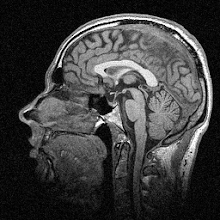Also, it is about babies. Yay babies!
Babies: hard to test but fun
Babies are hard to test. This is true for several reasons: they can’t give informed consent to studies, they can’t follow instructions and they can’t give verbal feedback. But that doesn’t stop people trying. Parents can give consent for their children; behaviours can be elicited by non-verbal means and recorded in lieu of verbal feedback. And of course it’s interesting to study babies in the first place to look at the development of the motor system.
In this paper, the authors look at clinical observation of four motor behaviours: abdominal progression (i.e. crawling), sitting motility, reaching and grasping motility. There are two distinct stages in infant motor development after birth that the authors identify: primary variability and secondary variability. General movements of the whole body that don’t appear to be geared towards accomplishing a task characterize primary variability. Secondary variability is much more task-specific and can be adapted to specific situations. It’s the transitions from primary to secondary variability in various motor behaviours that the authors are interested in.
To test when their infant participants began to make adaptive movements, they tested various children at various intervals ranging from 3 months to 18 months. Different types of movements were induced– for example, trying to get children to reach for toys or crawl towards them. The movements were recorded on video and two of the study’s authors scored the videos for whether the movements showed ‘no selection’ or ‘adaptive selection’. Since I am interested mainly in reaching, here are the results from the reaching scores (Figure 4 in the paper):
Selection in infant reaching movements across development
You can see that as the age of the baby increases in months, more ‘no selection’ movements occur (hatched bars). Then between 6-8 months you start getting ‘adaptive selection’ movements (black bars), which increase significantly in frequency between 6 and 8 months and between 12 and 15 months.
When rating videos like this, the reliability of the rating is very important. The authors tested inter-rater reliability by having two raters, but also intra-rater reliability by having the same rather rate the video once and then again after a month. Mostly they found that the reliability was very high, though it seems to me that they should perhaps have had a couple more raters in there just in case. To their credit, they do admit this as a limitation of their study.
So assuming that the rating is reliable, what do we now know? Well, it’s kind of interesting that for the four behaviours observed, the onset from the video ratings is a few months later in all cases than when you do neurophysiological testing (as people have done before). That is, if you measure brain activity (see the first picture in this post!) or muscle activity, you can observe patterns of motor activity that become noticeably more synchronized way before you can observe these changes by eye.
It’s useful to know this because you can’t hook every baby that comes into your busy clinic to a set of wires to record their brain and muscle activity, nor spend hours analyzing the results from these investigations. What you can do as a busy clinician is take note of the types of movements and when the transitions appear – as the authors note at the end, it would be interesting to do this kind of study on the ages of transition in infants with high probability of developing motor disorders (such as cerebral palsy).
Overall verdict: a nice short study with some possible clinical impact.
---
Heineman, K., Middelburg, K., & Hadders-Algra, M. (2010). Development of adaptive motor behaviour in typically developing infants Acta Paediatrica, 99 (4), 618-624 DOI: 10.1111/j.1651-2227.2009.01652.x
Baby EEG image copyright © 2010 Apple Inc.
Image from paper copyright © 2009 Heineman, Middleburg & Hadders-Algra



No comments:
Post a Comment